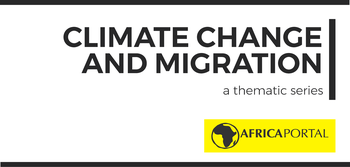
Victor Nyamori, an international migration practitioner and refugee rights lawyer in East Africa, shares his thoughts on the legal protection of climate refugees in the Horn of Africa. This is part of our series on Climate Change and Migration in Africa.
The Horn of Africa is a restive region characterised by internal and cross border population migrations associated with climate change, related conflicts and famine. From Ethiopia to Uganda, Eritrea to Somalia, and eastern Sudan to South Sudan, groups of peasant farmers and pastoralists have for years been on the move, running away from harsh climatic conditions or conflict and, in the process, precipitating new conflicts and further environmental crises.

Although the majority of climate displacements in the region are confined within state borders, a growing number of displaced groups are being forced to cross national borders when their crops fail, and livestock die. The greatest challenge to this group is that the 1951 UN Refugee Convention does not cover climate refugees and there is still debate on how the African Union’s 1969 Refugee Convention protects climate refugees. Without recognition, these peoples’ vulnerability to environmental stressors remains undefined, under-studied, and with minimal strategic interventions at all levels. We need better legal recognition of these groups within international, regional and state laws.
Threats facing climate refugees in East Africa
In 2010, I packed my bags and left Nairobi to start a new assignment as a Protection Officer with an international humanitarian organisation in Dadaab refugee camp, North Eastern, Kenya. At the camp, I came face to face with hundreds of thousands of refugees running away from Somalia. In 2011, most new arrivals were those running away from extreme conditions of drought that was ravaging the Horn of Africa region. It is estimated that across the region, over 900,000 Somalis had crossed borders to seek protection not only in Kenya but also in Ethiopia. Many remained within Somalia as internally displaced persons (IDPs).
“It was estimated that over 900,000 Somalis crossed borders to seek protection, not only in Kenya but also in Ethiopia.”
The life of arriving climate refugees was harsh and painful. Refugees told us harrowing stories of trails of death as they trekked from one place to another. With hostility in their own states, refugees had no option but to seek protection over the border. Many were killed in resource-related conflicts with communities they encountered on the way. The lack of drinkable water and food costed the lives of many.
Life in and around the Dadaab was not as favourable as expected for those arriving. By the end of 2012, the Dadaab refugee complex which was designed to host 90,000 refugees across the 3 sub-camps was hosting over 400,000 people, the majority of which were women and children from Somalia. Its natural and supplied resources were stretched to the limit. The largest refugee camp then, not only in Africa but across the world, was bursting at the seams. The situation was worsened by the reality that many communities in the semi-arid and arid locations in Northern Kenya were also facing similar challenges.
In fact, the drought that resulted in large scale displacement was not unique to Somalia. More than 12 million people were facing similar distressing conditions across the region. Djibouti, Ethiopia, Kenya, Somalia and Uganda were said to be facing the worst drought in 60 years. The majority of those affected moved internally, while some crossed international borders to seek protection. However, conflict between host communities and refugees frequently erupted.
Today, the converse is happening. True to the IGAD Climatic Prediction and Application Centre warning, the entire IGAD region has been facing ‘more than normal rainfall’ in the recent past. Thousands are currently being displaced or are at risk of displacement, as riparian villages and commercial centres around Lake Victoria in Uganda, Kenya, and Tanzania, and islands such as Rembe Island, are being submerged by the rising lake waters.
Looking forward, the World Bank’s Groundswell report predicts that climate migration will increase in the coming decades and the East Africa sub-region could see up to 12.1 million climate migrants on the move by 2050. A major part of this displacement is expected to be due to environmental changes resulting in flooding, drought and famine. Unlike conflict where there is a sudden and abrupt change of life, these climatic related displacements are normally slow and gradual, garnering minimal attention of local and international media. With less systematic documentation, the details surrounding the impact of climate-related displacements is yet to be fully understood.
What recognition and rights do climate refugees have?
Such massive internal and cross border movement of people has in recent years reignited debate on the various mechanisms and policies in place to address what is a growing crisis. While refugees, as defined under international law, are guaranteed protection under various policies, those who flee environmental and climatic changes do not enjoy this benefit.
The 1951 Convention relating to the Status of Refugees and its 1967 Protocol provides a relatively narrow definition of a refugee and does not cover individuals displaced by climate change, natural or environmental changes. Climatic refugees can therefore only claim basic violations or their human rights during these extraordinary circumstances, despite growing evidence that environmental changes are now a major factor affecting the movement of refugees and IDPs in the East and Horn of Africa.
In 2019, however, two major international mechanisms moved to recognise the plight of climate displacement. These are the Global Compact on Refugees, which regulates the sharing of obligations and the protection of refugees, and the Global Compact for Migration, which sets out the principles of safe and orderly migration. The Global Compact on Migration crystallised momentum on this debate by recognising climate change as a unique migration driver. The Compact, which was endorsed by almost all African states, introduces a unique concept of climate migration and encourages national and regional authorities to lead in addressing it. While the Compact does not create new legal entitlements per se, it invites governments to consider creating new visa categories and other forms of assistance for people forced to escape the impacts of floods, earthquakes, droughts, and rising sea levels.
“The Dadaab refugee complex was designed to host 90,000 refugees but by 2012, it was hosting over 400,000 people.”
Africa has also had some recognisable legal developments. The 1969 OAU Convention governing Specific Aspects of Refugee Problems in Africa extends the definition of a “refugee” to persons fleeing “events seriously disturbing public order”. It has since been argued that “events seriously disturbing public order” may apply to persons fleeing sudden-onset disasters, including climate refugees.
In addition, while the African Charter on Human and Peoples’ Rights (1981) does not specifically refer to climate refugees, it gives special consideration to the right to development and to the recognition that civil and political rights cannot be detached from economic, social and cultural rights. This is enough ground for the AU to encourage regional efforts that are cost-effective to host refugees and specifically climate refugees.
Moreover, as the majority of those who are affected and displaced by climate change remain internally displaced, many domestic laws and policies as well as regional instruments, have emerged following the African Union Convention for the Protection and Assistance of Internally Displaced Persons in Africa, adopted in Kampala in 2009.
Most recently, the African Unions’ Migration Policy Framework for Africa (2018 – 2030) and subsequent development Protocol to the Treaty Establishing Free Movement of Persons, Right of Residence and Right of Establishment in 2018 set ground for easing the challenges of cross border migration, including for those that migrate because of gradual environmental changes. The policy framework recognises that migration is a multi-faceted phenomenon that demands the action of different stakeholders at national and regional levels.
Free movement within regional economic communities (RECs) has been encouraged as a way of sorting out the challenges brought about by cross border movement caused by climate changes. The East and Horn of African states have recently taken steps in this direction. On the 26 February 2020, sectoral ministers approved the IGAD Protocol on Free Movement, setting a roadmap for its final adoption and implementation by regional states. Freedom of movement would curtail many of the violations and risks that border controls impose on climate refugees. It would facilitate entry and lawful stay in the region for those who are displaced.
Conclusion
While there has been progress in the development of policies and frameworks towards recognising and mitigating the protection and legal gaps faced by climate refugees, more still need to be done at the regional, continental and state level. There is a need to specifically integrate disaster and climate displaced persons into the international refugee law framework by allowing increased innovative and expansive interpretation of current international laws.
It is imperative that no climate refugee suffers from these legal protection gaps we can point out and correct now. The existing bilateral and regional protective programmes and provisions that have been used to protect climate refugees need to be strengthened to not only have a foundation in law but also to influence the development plans and policies of regional governments.
(Main images: A group of displaced children, who were forced to leave their houses due to heavy rains and floods in the area, gather while attending activities for children in an United Nations tent at a displacement camp for families affected by floods located in Beledweyne, Somalia, on 14 December 2019 – Luis Tato/AFP via Getty Images)
The views in this article are written in a personal capacity and do not necessarily reflect the views of organisation with which the author is associated. Similarly, the opinions expressed in this article are those of the author(s) and do not necessarily reflect the views of SAIIA or CIGI.
Enjoyed this? Then check out the rest of the Climate Change and Migration in Africa series here.


